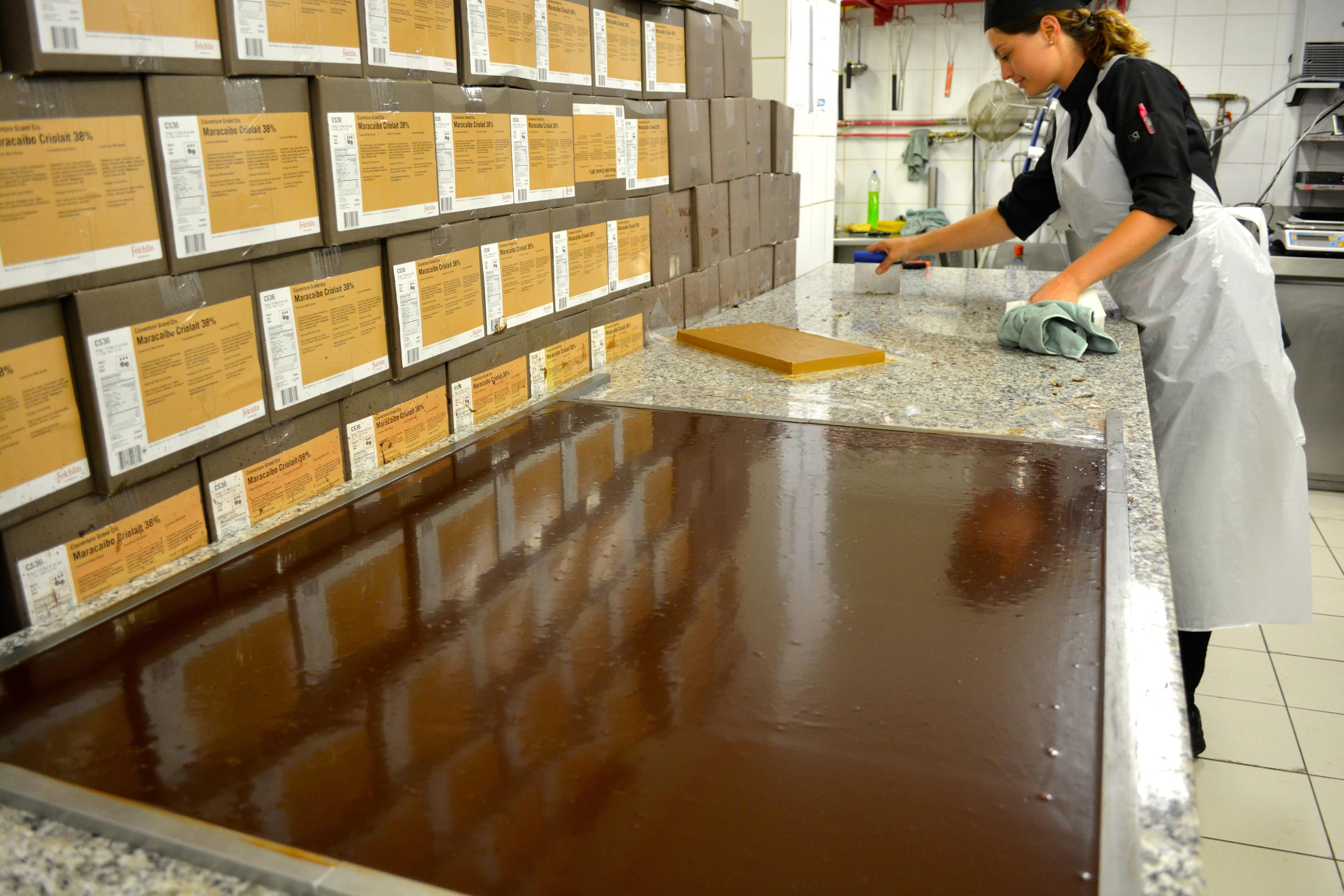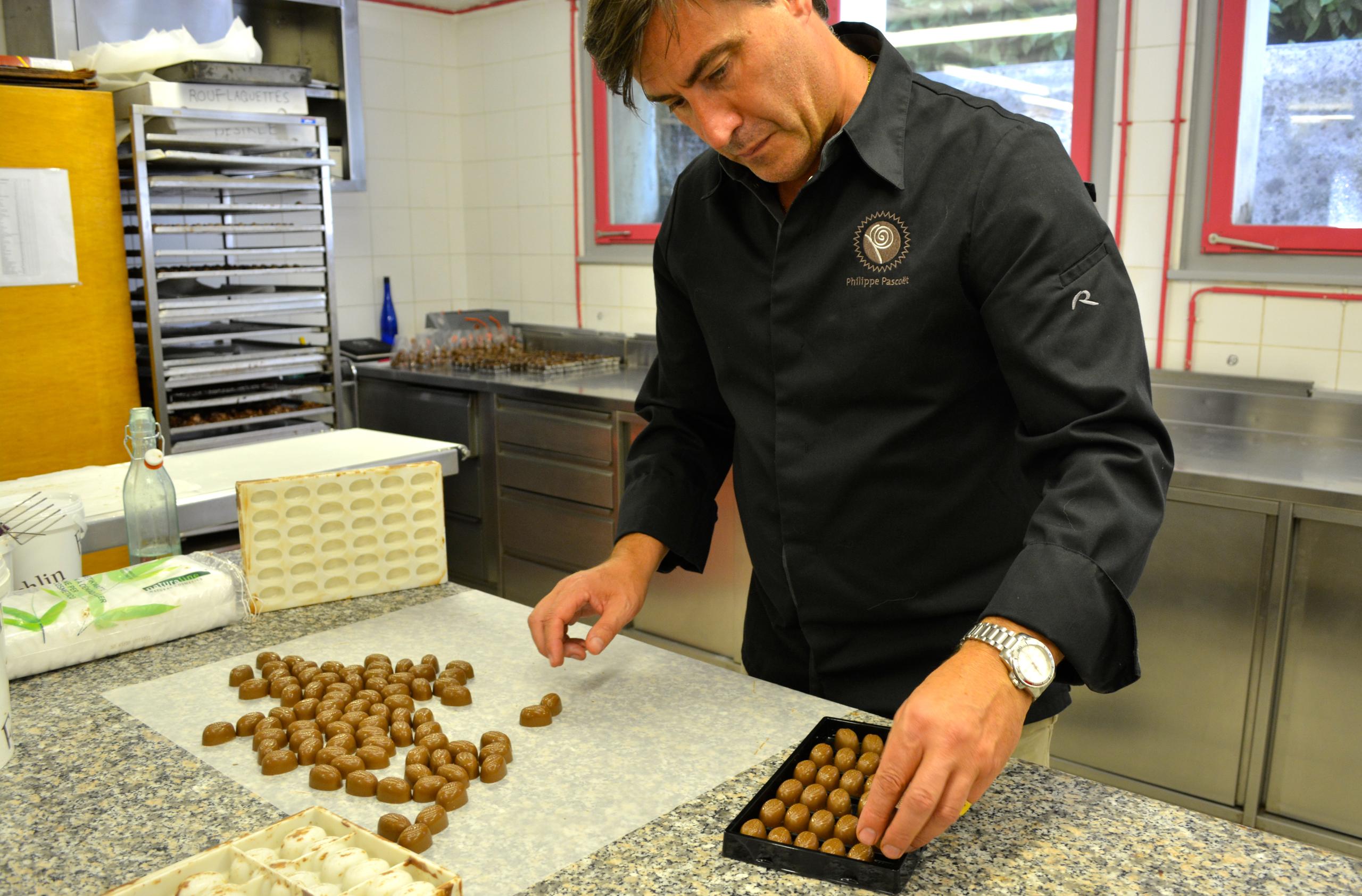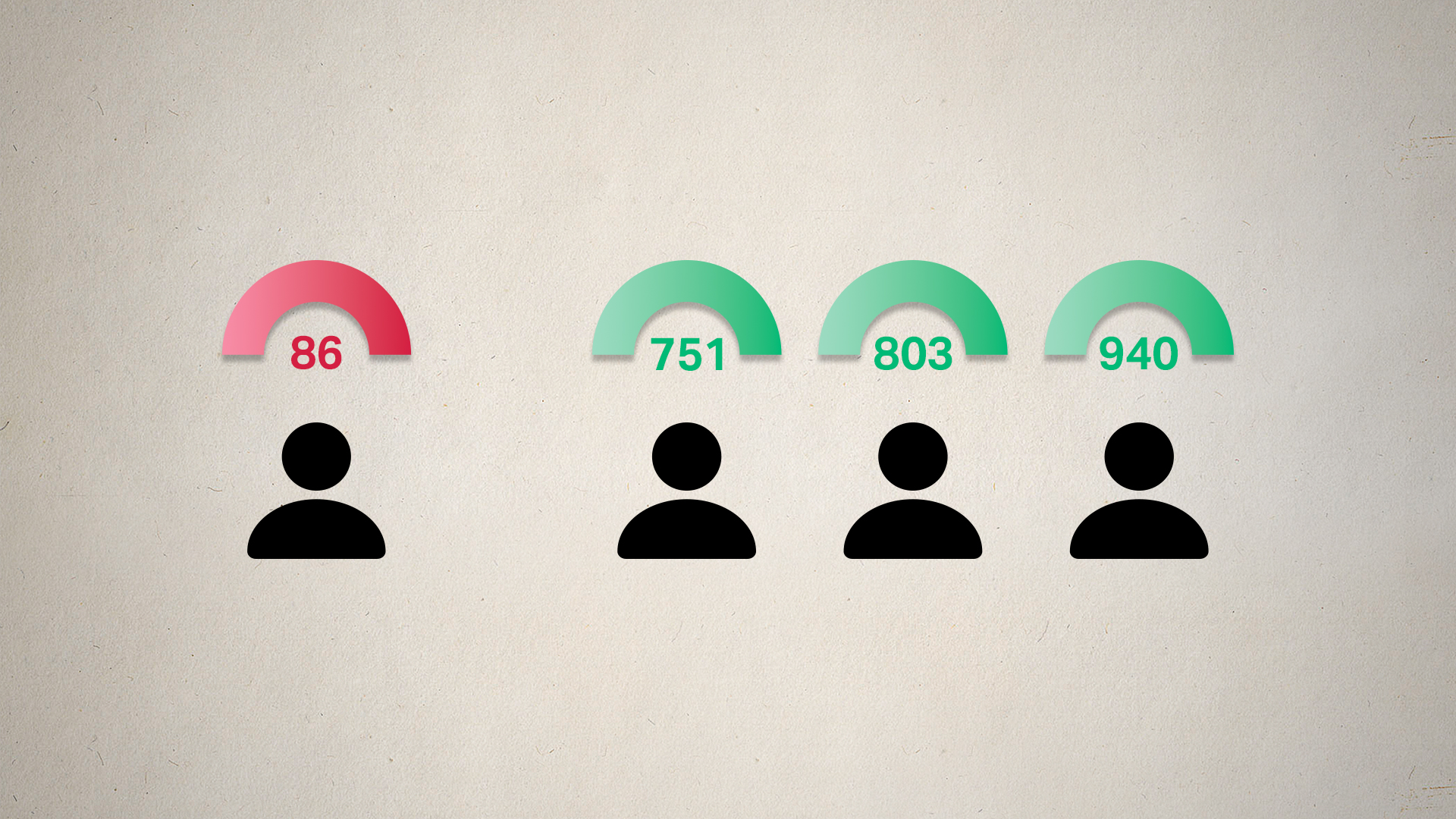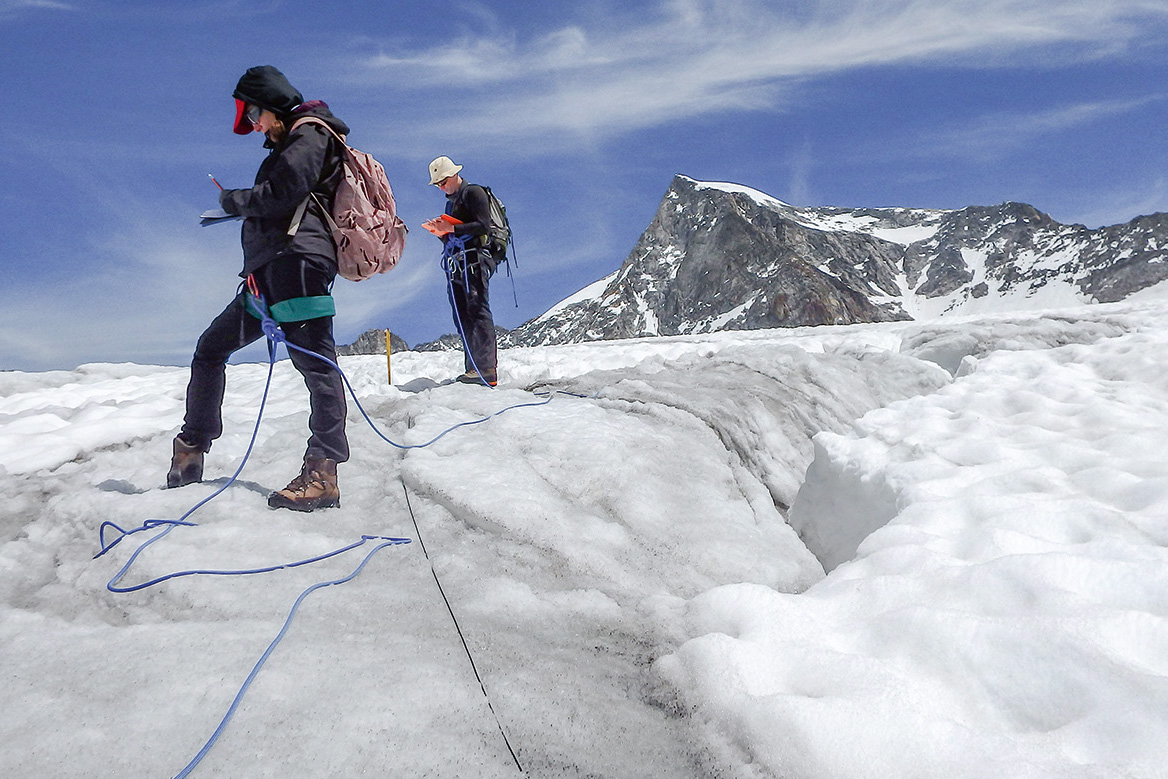
Overcoming chocolate’s bittersweet sources

With a move towards greater accountability, Swiss chocolate-makers, including end-of-the line confectioners, are marketing their sustainability plans, in what may sometimes be overly optimistic terms.
Tucked below a small shop in the Geneva neighbourhood of Carouge, Philippe Pascoët, a chocolate artisan known for his exclusive creations, explains from his workshop how clients are increasingly curious about the provenance of chocolate.
Working mostly with pure, high quality niche varieties, which he buys from Swiss chocolate producers, Pascoët points out a wild Bolivian variety, made from organic beans that are hand-picked from the jungle. “When we talk about biological or organic chocolate, these are chocolates which could have special appellations [like wines] but it would be too costly for the chocolate producer.”
But he is confident that while certifications, guaranteeing origins and good practices in production, were not indicated on the product packaging that he receives, “traceability exists from the beginning right to the end”.

He explains that for the first time last year, one of his suppliers even invited him to visit plantations in Latin America, to understand the product’s sourcing.
“PR effect”
According to the Cocoa BarometerExternal link, published by a consortium of NGOs that includes the Berne Declaration, the production of certified chocolate has risen dramatically since 2009, from 2% of all chocolate to 16% in 2013.
In an industry valued at $98.3 billion, a number of cocoa certifications now exist, including Fair Trade, UTZ and Organic as well as self-certification by many producers.
Andreas Von Arx, a Zurich-based food analyst at the investment brokerage Helvea, told swissinfo.ch that aside from assuring cocoa supplies to producers by supporting better conditions for poor farmers, sustainability programmes help chocolate companies achieve what he called a “PR effect” in face of public awareness of negative issues, such as child labour and palm oil exploitation, within the industry.
Last month, Zurich-based Barry Callebaut, the world’s largest chocolate buyer, announced that its new CEO starting in October would be Antoine de Saint-Affrique, an executive at consumer goods company Unilever, prompting speculation of an increased focus on sustainability. Unilever has, in recent years, rebranded itself as a corporate leader in environmentally-friendly production.
And next year, an international standard for sustainable cocoa is expected to be finalised, between the European Committee for Standardization and the International Organisation for Standardisation.
Self-certification
But Von Arx explained that on cocoa certification, “Often things can be a bit disorganised, and each company introduces their own programme, allowing it to achieve the maximum public relations benefits.”
Lindt & Sprüngli, for instance, which last year acquired US confectioner Russell Stover, explained in a statement to swissinfo.ch that it had its own programmes to support farmers, including the Lindt & Sprüngli Farming Program in Ghana.
“We aim to cover our entire cocoa supply with our Lindt & Sprüngli Farming Program by 2020, including an independent verification of the supply chain,” the company wrote.
“By implementing verification through independent third parties, we renew our ongoing full commitment to address the issue of child labour with concrete and measurable activities across the cocoa supply chain.”
At Barry Callebaut, Jens Rupp, head of sustainability communications, said that the firm “worked directly with farmers to provide a full picture of where the cocoa is produced and stored, in order to provide more traceability”.
The company offers a number of certified products, including Rainforest Alliance, Fairtrade, UTZ Certified and Organic cocoa, as well as from its own Quality Partner Program. Its website states that it works with cooperatives in Côte d’Ivoire and Cameroon and organises field schools to train farmers.
“We are keen to show customers what we are doing”, Rupp explained, adding, “It’s a Google world”, where consumers are interested in knowing where the food they eat is from.
As for Swiss food giant Nestlé, the company said that “to improve the lives of cocoa farming communities and the quality of the cocoa, we purchase through the Nestlé Cocoa Plan”. The programme trains cocoa farmers, builds and refurbishes schools and has “extended” its Child Labour Monitoring and Remediation System.
Mind the gap
International confectioners Hershey, Ferrero and Mars have committed to 100% cocoa certification by 2020 as part of Cocoa Action, an industry-led initiative. But their major producers and suppliers are presenting much lower figures.
Zurich-based Barry Callebaut, which supplies Hershey, reports on its website that 13% of its cocoa comes from certified sources. Ferrero, Nestle and Mars also have sourcing contracts with Barry Callebaut.
Another major cocoa and chocolate supplier, international commodities firm Cargill, says 20% of its cocoa beans are certified.
Lindt & Sprüngli said that it sourced its cocoa directly, making it a “main aspect of our business model to have full control over the entire value chain”. It did not specify what percentage of the beans were sustainably produced.
Nestlé has not signed up to the 2020 commitments on 100% sustainable sourcing. When asked about targets for the proportions of sustainably sourced cocoa, the company said that in 2015 about 25% of total purchases would be purchased through the Nestlé Cocoa Plan. It added that “around 88% of our 2014 cacao was certified to UTZ and Fairtrade standards”.
The Cocoa Barometer warns that double certification may sometimes skew figures. It said that while the three major certification groups, Fairtrade International, UTZ Certified and Rainforest Alliance, certified 1.4 million tonnes of cocoa, representing 30% of the global market, “it is unknown how much of the cocoa that originates from farmer groups they control is double or even triple certified. This means the same tonne could be counted as certified by more than one standard body.”
Most farmers unaccounted for
So is the goal of 100% certification hailed by confectioners realistic when some of the biggest producers are still far from the target?
“The question is not [what is happening] now, but what the situation will be in 2020 to 2025″, analyst Von Arx said.
Efforts to increase public awareness, as demonstrated by the Cocoa Barometer, may further motivate some confectioners who still are not sensitive to sustainability issues. But challenges still prevail.
Barry Callebaut’s sustainability spokesperson said that while he thinks “it is important to show customers what we do in a transparent way”, some customers ask for traceability, “but not all of them”.
And for the farmers themselves, access to the certification process is not universal.
Sako Warren, secretary general of the International Cocoa Farmers Organization, explained that 80-90% of cocoa production comes from small independent farmers, located in remote areas. But “buyers and traders can only reach a minority of farmers” who may work in certified cooperatives where sustainability programmes are being implemented, he said.
Warren said that while he agreed that certification was needed, “the current method is causing a lot of problems and frustration among farmers. There should be a better way to implement the programmes”. He said that small farmers, responsible for assuring cocoa production and meeting the growing global demand for chocolate, needed to be consulted by the various stakeholders.
Until now, his organisation, which represents all cocoa farmers, including smaller growers, has not been included in industry discussions about how to improve the lives of those working at the source of supply chain.
In West Africa, where approximately 70% cocoa supply originates, poverty and child labour is widespread.
“We think that the big chocolate makers and governments of producing and consuming countries should come together with farmers’ organisations to tackle these problems together. 80-90% of cocoa farmers who are responsible for 90% of production are missing from the debate.”
Palm oil
With rising prices for cocoa butter, chocolate producers and confectioners are using more palm oil, a cheaper substitute, according to Euromonitor International. The substitute, also known in the industry as cocoa butter equivalents (CBE), is being increasingly employed in chocolate fillings. In Europe regulations limit its use to certain amounts.
A few years ago, a graphic PR campaign launched by Greenpeace, against Nestlé, the maker of Kit Kat chocolate bars, accused the company of illegal deforestation and the destruction of habitats of endangered animals, for palm oil plantations.
In 2004, a certification system was introduced by the Roundtable on Sustainable Palm Oil (RSPO), a non-profit group set up by producers and consumers, including a number of NGOs. Certified palm oil needs to come from previously used agricultural lands but critics say that old problems persist.
Child labour in cocoa production
A studyExternal link published in July by Tulane University in the United States reports that instead of decreasing, child labour has increased in West Africa, where approximately 70% of cocoa originates. It said that in 2013/2014, over 2.2 million children worked in cacao production in the two largest producing countries, Ghana and Côte d’Ivoire.
Although the number of children working in the crop’s production who attended school rose in both countries, 96 percent of children working in the industry still continued to be involved dangerous tasks, rising 13% from 2008/2009. Dangerous work included use of machetes and harvesting hooks, carrying heavy loads and manipulating toxic fertilisers.

In compliance with the JTI standards
More: SWI swissinfo.ch certified by the Journalism Trust Initiative




































You can find an overview of ongoing debates with our journalists here . Please join us!
If you want to start a conversation about a topic raised in this article or want to report factual errors, email us at english@swissinfo.ch.